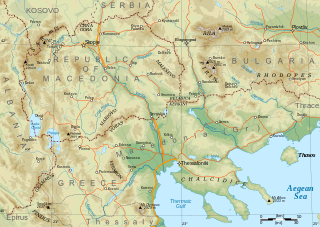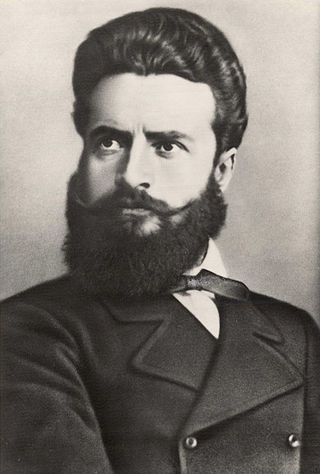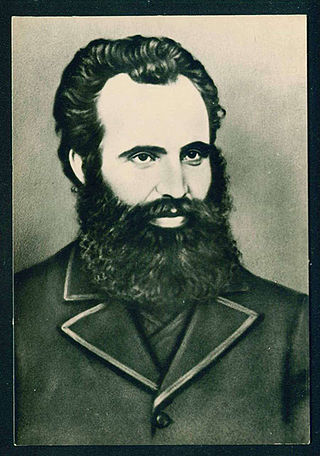
Macedonia is a geographical and historical region of the Balkan Peninsula in Southeast Europe. Its boundaries have changed considerably over time; however, it came to be defined as the modern geographical region by the mid-19th century. Today the region is considered to include parts of six Balkan countries: all of North Macedonia, large parts of Greece and Bulgaria, and smaller parts of Albania, Serbia, and Kosovo. It covers approximately 67,000 square kilometres (25,869 sq mi) and has a population of around five million. Greek Macedonia comprises about half of Macedonia's area and population.
The history of Bulgaria can be traced from the first settlements on the lands of modern Bulgaria to its formation as a nation-state, and includes the history of the Bulgarian people and their origin. The earliest evidence of hominid occupation discovered in what is today Bulgaria date from at least 1.4 million years ago. Around 5000 BC, a sophisticated civilization already existed which produced some of the first pottery, jewellery and golden artifacts in the world. After 3500 BC, the Thracians appeared on the Balkan Peninsula. In the late 6th century BC, parts of what is currently Bulgaria, in particular the eastern region of the country, came under the Persian Achaemenid Empire. In the 470s BC, the Thracians formed the powerful Odrysian Kingdom which lasted until 46 BC, when it was finally conquered by the Roman Empire. During the centuries, some Thracian tribes fell under ancient Macedonian and Hellenistic, and also Celtic domination. This mixture of ancient peoples was assimilated by the Slavs, who permanently settled on the peninsula after 500 AD.

An exarch was the holder of any of various historical offices, some of them being political or military and others being ecclesiastical.

Vasil Levski, born Vasil Ivanov Kunchev, was a Bulgarian revolutionary who is, today, a national hero of Bulgaria. Dubbed the Apostle of Freedom, Levski ideologised and strategised a revolutionary movement to liberate Bulgaria from Ottoman rule. Levski founded the Internal Revolutionary Organisation, and sought to foment a nationwide uprising through a network of secret regional committees.

Hristo Botev, born Hristo Botyov Petkov, was a Bulgarian revolutionary and poet. Botev is considered by Bulgarians to be a symbolic historical figure and national hero. His poetry is a prime example of the literature of the Bulgarian National Revival, though he is considered to be ahead of his contemporaries in his political, philosophical, and aesthetic views.

The Bulgarian Orthodox Church, legally the Patriarchate of Bulgaria, is an autocephalous Eastern Orthodox jurisdiction based in Bulgaria. It is the first medieval recognised patriarchate outside the Pentarchy and the oldest Slavic Orthodox church, with some 6 million members in Bulgaria and between 1.5 and 2 million members in a number of other European countries, Asia, the Americas, Australia, and New Zealand. It was recognized as autocephalous in 1945 by the Ecumenical Patriarchate of Constantinople.

The Bulgarian Revival, sometimes called the Bulgarian National Revival, was a period of socio-economic development and national integration among Bulgarian people under Ottoman rule. It is commonly accepted to have started with the historical book, Istoriya Slavyanobolgarskaya, written in 1762 by Paisius, a Bulgarian monk of the Hilandar monastery at Mount Athos, leading to the National awakening of Bulgaria and the modern Bulgarian nationalism, and lasting until the Liberation of Bulgaria in 1878 as a result of the Russo-Turkish War of 1877–1878.

The Bulgarian Revolutionary Central Committee was a Bulgarian revolutionary organisation founded in 1869 among the Bulgarian emigrant circles in Romania. The decisive influence for the establishment of the committee was exerted by the Svoboda ("Freedom") newspaper which Lyuben Karavelov began to publish in the autumn of 1869. Some of the other revolutionaries who took active part in the formation and work of the BRCK were Panayot Hitov, Vasil Levski and Dimitar Tsenovich.

The Bulgarian Exarchate was the official name of the Bulgarian Orthodox Church before its autocephaly was recognized by the Ecumenical See in 1945 and the Bulgarian Patriarchate was restored in 1953.

Unification Day on 6 September is a national holiday of Bulgaria. It commemorates the unification of Eastern Rumelia and the Principality of Bulgaria in 1885.

The Principality of Bulgaria was a vassal state under the suzerainty of the Ottoman Empire. It was established by the Treaty of Berlin in 1878.

Lyuben Stoychev Karavelov was a Bulgarian writer and an important figure of the Bulgarian National Revival.

The Bulgarian Greek Catholic Church is a sui iuris ("autonomous") Eastern Catholic church based in Bulgaria. As a particular church of the Catholic Church, it is in full communion with the Holy See. The Church's liturgical usage is that of the Byzantine Rite in the Bulgarian language. The Church is organised as a single eparchy — the Bulgarian Greek Catholic Eparchy of Sofia.

Nikola Tihov Obretenov was a Bulgarian revolutionary, one of the combatants for the liberation of Bulgaria, and a participant in the Stara Zagora Uprising and the April Uprising. His book "Memories About Bulgarian Uprisings" was published posthumously and is a primary source of historical information about those events.

Nayden Gerov, born Nayden Gerov Hadzhidobrevich February 23, 1823, Koprivshtitsa – October 9, 1900, Plovdiv) was a Bulgarian linguist, folklorist, writer and public figure during the Bulgarian National Revival.

Theodosius of Skopje was a Bulgarian religious figure from Macedonia who was also a scholar and translator of the Bulgarian language. He was initially involved in the struggle for an autonomous Bulgarian Church and later in his life, he became a member of the Bulgarian Academy of Sciences. Although he was named Metropolitan Bishop of the Bulgarian Exarchate in Skopje, he is known for his failed attempt to establish a separate Macedonian Church as a restoration of the Archbishopric of Ohrid. Theodosius of Skopje is considered a Bulgarian in Bulgaria and an ethnic Macedonian in North Macedonia.

In AD 1453, the city of Constantinople, the capital and last stronghold of the Byzantine Empire, fell to the Ottoman Empire. By this time Egypt had been under Muslim control for some eight centuries. Jerusalem had been conquered by the Rashidun Caliphate Muslims in 638, won back by Rome in 1099 under the First Crusade and then reconquered by Saladin's forces during the siege of Jerusalem in 1187. Later in the seventh Crusade, it was briefly taken back by the Catholics once again. It was conquered by the Ottomans in 1517. Orthodoxy, however, was very strong in Russia which had recently acquired an autocephalous status; and thus Moscow called itself the Third Rome, as the cultural heir of Constantinople. Under Ottoman rule, the Greek Orthodox Church acquired power as an autonomous millet. The ecumenical patriarch was the religious and administrative ruler of the entire "Greek Orthodox nation", which encompassed all the Eastern Orthodox subjects of the Empire.

Rūm millet was the name of the Eastern Orthodox Christian community in the Ottoman Empire. Despite being subordinated within the Ottoman political system, the community maintained a certain internal autonomy.

Bulgarian Millet was an ethno-religious and linguistic community within the Ottoman Empire from the mid-19th to early 20th century.

The Macedonian Apostolic Vicariate of the Bulgarians, informally Macedonia of the Bulgarians, was one of the missionary, pre-diocesan jurisdiction of the Bulgarian Greek Catholic Church sui iuris.























